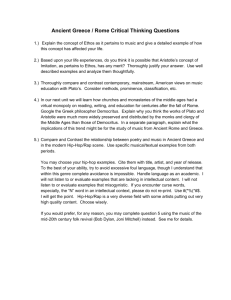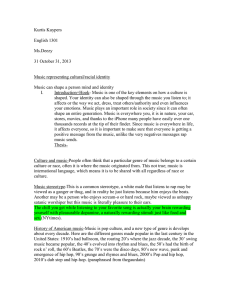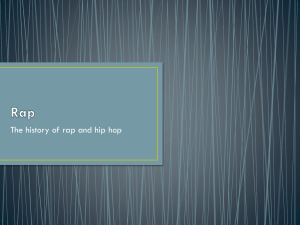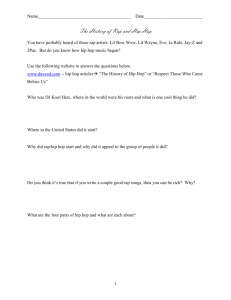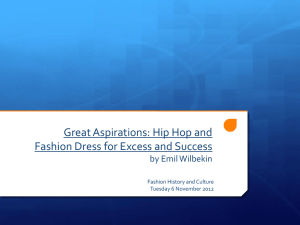The role of Hip Hop in all of this is not as simple either. The likes of
advertisement
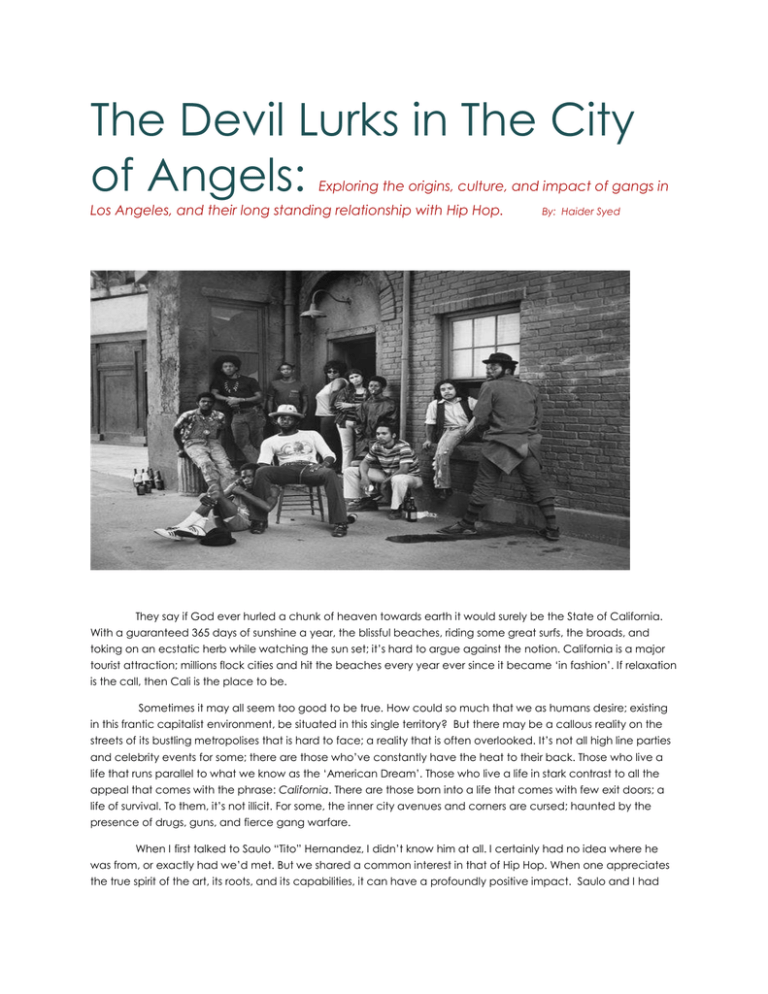
The Devil Lurks in The City of Angels: Exploring the origins, culture, and impact of gangs in Los Angeles, and their long standing relationship with Hip Hop. By: Haider Syed They say if God ever hurled a chunk of heaven towards earth it would surely be the State of California. With a guaranteed 365 days of sunshine a year, the blissful beaches, riding some great surfs, the broads, and toking on an ecstatic herb while watching the sun set; it’s hard to argue against the notion. California is a major tourist attraction; millions flock cities and hit the beaches every year ever since it became ‘in fashion’. If relaxation is the call, then Cali is the place to be. Sometimes it may all seem too good to be true. How could so much that we as humans desire; existing in this frantic capitalist environment, be situated in this single territory? But there may be a callous reality on the streets of its bustling metropolises that is hard to face; a reality that is often overlooked. It’s not all high line parties and celebrity events for some; there are those who’ve constantly have the heat to their back. Those who live a life that runs parallel to what we know as the ‘American Dream’. Those who live a life in stark contrast to all the appeal that comes with the phrase: California. There are those born into a life that comes with few exit doors; a life of survival. To them, it’s not illicit. For some, the inner city avenues and corners are cursed; haunted by the presence of drugs, guns, and fierce gang warfare. When I first talked to Saulo “Tito” Hernandez, I didn’t know him at all. I certainly had no idea where he was from, or exactly had we’d met. But we shared a common interest in that of Hip Hop. When one appreciates the true spirit of the art, its roots, and its capabilities, it can have a profoundly positive impact. Saulo and I had interacted on a fan page for one of our favorite artists, arguing over a post about a track he’d put out. Despite never meeting in person, we forged a strong friendship, Sharing our experiences about our past endeavors in life gave me a glimpse of how much we had in common, despite growing up in distinct environments. Even though we were bought up in different parts of the world, having our own families and background, and even striving for different means, we had been impacted in the same way by this genre of music. One of the most striking of these discussions was about the issue of violence in Hip Hop, and how it is promoted by the ‘Gangsta Rap’ genre. Yet, as I dwelled deeper into the story of one individual’s experiences with gangs in his own city, it occurred to me, that not only had I been misled in regards to this issue, but Hip Hop also had a much more profound relationship with ‘gang life’. According to Tito, gang culture is prevalent throughout the city of Los Angeles and its many districts. It has become encrusted within the social make up of city life, and something that everyone takes notice of, but few confront. Growing up, the lure of gang life is intriguing because it offers so much in such little time. This is prevalent in many neighborhoods across America, yet this particular city represents the ‘birthplace’ of this culture. Engrained in this street life are the fundamentals of respect and honor, which are key in terms of acquiring ‘power’. It is a vicious cycle where respect is earned on merit of action and power is gained by the amount of respect you garner, and vice versa. While recently watching a show, a thought that struck out to me was when renowned British musician Akala bought up the issue of why youth in Brixton were running around with bandanas hanging out of their back pockets. It was a good question; why on earth would male teenagers, thousands of miles away in the back alleys of a London borough, be inaccurately mimicking a culture so foreign to them? But the answer lies in the deeper realms of the history of Los Angeles. It seems that this culture might be misrepresented, misinterpreted, and misunderstood by many, and a contributing factor in this deception is the reoccurring role of Hip Hop. But gangs didn’t always exist in Los Angeles, and there is a peculiar story behind it all. For the most part, just like the rest of the United States, the mob got its big break during the prohibition era, when the likes of Al Capone, Bugsy Siegel, John Dillinger, Charles Diamond and Charles Luciano spread chaos in a time of dreary financial crisis. But the 17 year olds hanging out on the block are not the descendants of the infamous outlaws of the Wild West that became an essential part of the ‘Great American Story’ about the frontier. But these youth are neither the relatives of Irish or Jewish immigrants who ran a monopoly in the criminal underworld of New York for much of the late 19th and early 20th century. Neither are they the grand children of Italian mobsters that spread havoc around Chicago while controlling much of the liquor sales during prohibition, galvanizing the gambling industry and leading the prostitution links. No, these kids were born in a different time, almost put into this situation, because of what they believed in. It is essential to understand the differences between the creation of these groups and their motives. During the reconstruction era and onwards, the unexplored frontier was transformed by the railroad and it expanded from across the mountain plains to the bay of San Francisco. But this time was difficult and just as in the latter depression years, the West was the victim of a brand of ‘mobster’ that spread fear in travelers and locals. But overtime, these bandits became much more complex and sophisticated in their work, turning their profession into a business. Gangs started out as early as the 1920s in the Los Angeles area. Although they were few in numbers, they were, according to one source, “family based”. Being small in size, they resorted to petty crimes such as stealing auto mobile parts and robbing pedestrians in the west side of the city. The Zoot Suit Riots in 1943 led to an unprecedented boiling point in racial tensions in LA, and spread throughout the country, inspiring the likes of Malcolm X. But by the 1950s these groups in LA, had started to focus on protection more than anything else. After an increase in racial violence from within the white community, these groups looked to protect and serve their own communities. The legal housing discrimination laws were countered through these groups, which had prevented the black community to integrate into white neighborhoods. Due to overcrowding and growing populations within their own communities, living conditions worsened and white gangs such as the Spook Hunters violently targeted black youth. According to Raymond Wright, who started a group of his own, “you couldn’t pass Alameda, because those white boys in South Gate would set you on fire, and fear of attack among black youths was not, surprisingly, common. In 1941, white students at Fremont High School threatened blacks by burning them in effigy and displaying posters saying, we want no niggers at this school” (Bunch 1990: 118). By the 1950s, many groups were formed on the basis of fighting the white establishment. By the 1960s these mobs were neither forgotten nor gone. America was fighting a new battle as war lingered on in Vietnam. As mothers sent their children to die in a distant land, the West tried to contain the ideological mantra of Communism across the globe. America was embroiled in an ideological battle that threatened to ‘destabilize’ its social atmosphere and restructure it forever. Racial tensions were clearly at a high across the nation. As one man spoke of his dream on the steps of the Washington Memorial, Ruby Bridges was heckled at while trying to go to school. While John Coltrane’s saxophone could be heard on every street corner, a speaker by the name of Malcolm Shabazz was gunned down at the Audubon Ballroom in Harlem. America was, without knowing it, undergoing a revolution. The ‘Black Power’ movement is shrugged upon to this day, it strikes fear into the hearts of many, but that is only down to the product of many misunderstandings. Black Power was simply to empower African Americans into seeking equality and freedom from the dire situation they found themselves in. In the 1960s, the Black Panthers bought a new brand of protest in the form of self-determination and selfdefense against the oppressive authority that had put them in this position in the first place. The Civil Rights Era bought about a new style of policing as well. This was a major contributor to why these groups were forming all over the nation. There was a general fear among the white, suburban, middle class population, which the population also gave into. These fears were exemplified in no better way than the extensive COINTELPRO agenda that sought to put an end to the Martins and Malcolm’s popping up all over the nation. It administered the wiretapping, surveillance, threatening and oppressing those involved in the struggle. By 1971, 2 million African Americans were being arrested yearly, as prison populations continued to rise. Police Brutality was in full force with the harassment endured by men, women, and youth of African descent; the old and the weak, no one was spared. At a time as such, drastic measures had to be taken, and self-defense was vital to any hopes of ending the abuse. Huey Newton along with Bobby Seale, vowed to do just that. They targeted the young, reckless, and disinterested who were putting their abilities to the wrong use. By the late 1960s, the Black Panther party had started to get national recognition for their efforts of resistance. They were prevalent as a party, in major cities across the United States, striving for "Land, Bread, Housing, Education, Clothing, Justice and Peace", as shown in their 10 point plan. The Panthers as a party were organized, well structured, and prepared. These qualities were what led to their success; reporting police behavior and armed patrols of neighborhoods. As a population, AfricanAmerican youth started to look up to the likes of Huey Newton, Fred Hampton, and others. As time wore on, they focused more on social causes such as alleviating poverty and curbing the criminal culture within their own communities. Their much acclaimed breakfast program fed thousands of children daily across Oakland, California. But the party began its decay as members were accused of being involved in criminal activities, and the stories of many such as Sekou Odinga and Mumia Abu Jamal are well known to many. The Black Panther Party was just one of many groups that sought to protect their communities, across the nation. In LA, the legacy of the panthers and their decay highlighted the ‘split’ in ideologies. The COINTELPRO program had been designed in a way such, to cripple the mere backbone of this revolution; unity. The unification of these groups was caused by a multitude of events. The Panthers argued over policies it should be using, such as violence even in the case of protection against police brutality, which mostly turned bitter. As the Panthers began to fall, members incarcerated, killed, forced into exile, and financially in distraught, the party lost its charisma and purpose. The coming years bought back a difficult time for many parts of America. Los Angeles was a witness to the severe escalation in violence and crime. The death of the civil rights era bought about a generation once again looking for leadership and finding purpose in a turbulent society. Los Angeles has always been a segregated city, with Blacks, Whites, and Hispanics separated by not only culture but neighborhood. During the 1970s, Raymond Washington formed his Community Resources for Independent Peoples. They sought to counter the same problems as the Black Panthers, and based their organization on their principles. It wasn’t just the black leather jackets they adopted from the Panthers, but also their tactics and organizational style was quite similar. Washington had learnt how to control and reorganize these neighborhoods from elder community leaders and sought to do the same in the wake of the ‘end’ of the Black Panther Party. But as time wore on, it became more about ‘identity’, as other local gangs clashed with the Crips over how the neighborhoods should all be run. At the same time, the Crips began to spread throughout the city from the east side to the Compton area. Stanley ‘Tookie’ Williams formed his own West side Crips crew and violent clashes became more common by 1972. By this time, the Crips occupied over 45 neighborhoods in the city, and challenged anyone who resented their methods, and so a bitter rivalry began. The Crips became an ‘identity’ rather than a gang, as others merely adopted their style and teachings, and so as time wore on, other gangs came to challenge them, and conflict of control over these neighborhoods bought the city to its knees. As much as the history of gang culture is important, there were numerous reasons to why gang culture ran rampant in America. The Crack Era had left the African-American community in shambles along with many other ethnic minorities. Immigration increased during this time, as families left their war torn homelands in pursuit of the American dream. When one culture meets another, there is an exchange of ideas, philosophies and tradition throughout the United States. Hip Hop played a phenomenal role in shaping the American culture during this time. Long gone were the days of the civil rights era, and the disengaged youth found solace in rap music. One genre that grew out of this time was ‘Gangsta Rap’. The 1980s was a time of grief and misery for some, and the introduction of crack cocaine into the streets of America had a detrimental impact. For the African-American population along with others, it bought about a whole lot of other problems. Thousands were hooked in no time, and soon families were broken apart, dreams shattered, and individuals tormented by their own misery. Coke bought about a new life style as well, for some it may have been a demon, to others it was a blessing. The Narcotics trade doubled if not tripled during this time. For the one who was dealing cocaine, it bought money easily and fast. This lifestyle became epitomized as a sub-genre of rap music. With no Malcom or Huey to guide them, the African-American population for the most part was left in a state of melancholy. There came to be a culture and code of ‘survival’ that gripped the populous; either one struggled through or died out like the rest of them. So slinging cocaine on the corner was not preference but a requirement. Gang culture escalated once again during this time, as poverty saw an increase in violence and crime. When a man cannot feed his starving children, when the government won’t give you food stamps, that’s when the militant mindset kicks in; and so the individual is left with nothing to do but to start robbing and stealing. Or so it would seem that it would be the alternative, that getting an education or righteously earning one’s money could be done, but at a time like this, no one had the luxury of going to school or pursing their dreams. Coupled with policies such as ‘Reaganomics’, crime was the only option. The rise in consumer culture that dominated American society played its part in influencing youth to fulfill their desires no matter what they had to resort to. So teenage boys started to fight over worthless objects such as a pair or Air Jordan’s or Reeboks. This situation was when the young are mostly miserable and vulnerable to becoming affiliated with gang culture. When society alienates the youth, they can only find respect, honor, and dignity within a gang. When no one accepts you, the elder gang member shows a boy the chemistry behind converting cocaine for the street, because his fathers locked up. It wasn’t in their blood or genetic makeup to do so, but one learns violence when there is no other option. The role of Hip Hop in all of this is not as simple either. The likes of Ice T, NWA, KRS One, Cypress Hill, Kool G Rap, Big Daddy Kane, and others didn’t sell records for the fun of it. They were a generation that grew up in the crack era, and for the likes of Ice T, it was a method of ‘getting out’. If drugs and guns had been the mainstay alternative to living in poverty and isolation, if the needle had been the only way out of the ghetto, then these men would not have started rapping. But seeing to the horrid implications of living the ‘gangsta’ life, they chose to reflect on their past experiences and share their thoughts. These rappers took it to themselves to distribute their own stories so that another younger generation would not get sucked into that same life. However, as the record industry grew to have a major influence on artists, which is quite prevalent today, there was a continuity in this sub-genre as well. Despite it being over 30 years since the time that the veterans came out, their style of music changed. Gangster Rap has always had a rugged style, raw, uncut truth about events on the street. It is based on the same attributes that one would find in the street or a gang, such as ‘respect’, ‘hardness’ and ‘honor’. The likes of Ice T and Ice Cube went on to have successful careers and even resorted to making a career out of their past experiences. They started out rapping about their lives on the street, but there was growth as their own life styles changed, their music changed as well to fit their current situation. In terms of rap today, it glorifies the gangster life for the wrong reasons. The veteran group of this rap genre wrote verses to parallel their own realities, but the rappers of today have changed that. Instead of glorifying life and happiness, cotemporary rap music tells the listener how ‘hard’ it is to still live that same life of petty crimes, and that selling drugs on the corner is the right way to make money. The rap game today has left the image of gangsta rap, and its legacy not only in tatters but disfigured as well. When a rapper has been rich for 10 plus years and still tells his fans that he lives in the hood, carries a gun, and sells drugs, then there is a problem. It’s ironic that he tells his fans to rob and steal, because an education won’t give you that success, yet sends his own children to a private school. Hypothetically speaking, many rappers may be credible in their message of living such a ‘hard’ life, but as time goes on they should evolve as their economic position changes for the better. Rappers nowadays have taken to making a career off their style that bought them success in the first place, thinking that their fans won’t buy their music, if they choose to change. The threat of being labelled ‘soft’ is something that keeps them from doing so. The Corporate growth of the Hip Hop Industry has also helped the growth of this genre of Hip Hop. The artists may have been sharing life experiences, but the record executives took advantage of their stories. They were sold a dream of quick success and so continued to sell the same old sound that people bought into. The gangsta culture has been glamorized and showed to be something that brings respect. The fiasco of growing prison populations mirror the growing ideology that going to prison shows how ‘hard’ one can be. In the past decade or so, the likes of 50 Cent, G-Unit, TI, and Jada kiss. Rick Ross, among others have fed the growth of this culture by promoting the same old vices in their music. Unlike the generations before, rappers have not told their audience to leave behind that live style, but told them to embrace it heartedly to show their integrity and credibility. Hip Hop has undoubtedly come a long way from being an art from of the oppressed to a highly controlled multi billion industry. The Gangsta rap genre has played its part, sadly, in leading the youth astray to a path of life that gives little in relation to what it promises. It has come a long way from the soulful and beats of revolution that taught us about Malcom and Martin to a style that instructs us to degrade women and blindly follow a pointless routine. But Hip Hop has hope in the form of resistance. Hip Hop is at war with itself, the mainstream against the underground, the conscious against the industrial executives. Hip Hop has always played a major role in shaping the culture of its time, and can once again teach. Gang culture is still prevalent in many parts of the world, starting from the corners of Oakland and the West Side of Los Angeles. But there are many examples in history that show us that an individual’s thinking can be altered, even when they are at the lowest point. It seems the stuff of near legend; stories of the Young Lords Movement and the likes of Afrikka Bambataa. The Young Lords started out as a drug infested gang, yet under the leadership of Jose Cha-cha Jimenez, they were able to turn away from the street to fight for Puerto Rican liberation, Hispanic rights, and freedom for all the oppressed of the world. Other such as the likes of Fred Hampton were able to do something that no police force or mayoral council was able to do so before. He had single handedly united all the Chicago gangs under one banner of justice and unity, before being violently crucified during a police raid. Other examples are that of one of Hip Hop’s founding father; Afrikka Bambaataa, who while being a member of the Black Spades in New York, helped to clean up his own community of drugs and violence. Yet his biggest contribution to not only Hip Hop but the city as well was to promote block parties. His establishment of the Zulu Nation in the 1970s helped to globalize Hip Hop and turn it into a form of living. Rather than kids blasting guns, they were blasting boom boxes, rather than selling drugs, they sold tickets to shows and records. They were taught to go to school, live positively, teach others, and go on to be successful in life; they could be scholars and doctors. The Zulu Nation is a testament to the positive growth that Hip Hop can bring and help to truly turn around an individual’s life. Tito grew up in a city embroiled in gang culture, yet pays tribute to Hip Hop music something that helped him see sanity in all the insanity. He attributes the likes of Immortal Technique, who helped him to mature and find purpose in life. “I’ve seen people join gangs because it’s the only life they know, they grow up around it, and so that’s the only way they know how to make a living”, he tells me when I asked him why exactly someone would join a gang. Tito believes that gang culture is so rampant in some areas that it is the only way to survive, that when push comes to shove, when you’ve got no money, you try to fix your problems quickly, and drugs are an easy way through. Gang culture is something that has influenced us heavily, even growing up in a near welfare state such as Canada where we have quite adequate living conditions, there is a struggle that undoubtedly exists for some more than others, yet not to an extent as other places around the world. Yet many youth still believe that selling drugs is cool, and this rap music has them mesmerized to such a point where they see nothing but the Scarface fantasy that they have been force fed. Regardless of who is saying what, this is a critical issue. The fact of the matter is quite simple; there are people dying. The innocent are falling victim to a social pariah in the form of this brainwashing that the industry is conducting. Regardless of the intentions of the artists, their music has more influence on the lives of kids than their own parents do. We all remember too well that it was Hip Hop that had kids dressing up in pink clothes not too long ago. Its simple things like this, things we choose to ignore, that are actors in a larger play. There are able bodied minds falling victim to a false image that they see all around them; glamorized, glorified, and portrayed with mass appeal. It’s difficult to resist, speaking from a personal point, what we see, and how we see is something very important when it comes to making decisions. But young men are throwing their lives away for false hopes, pitting themselves in a dreary façade. There are kids who sell drugs and fall victim to drug abuse, start families, and are ignorant to their own children who look for a way out, and so continues a vicious cycle. Our phycology as a society must change, truthfully, there is nothing wrong with what type of music people make, but it is up to us to teach our children how to perceive the world. We must learn to differentiate between lesson and entertainment, and only then can we hinder the downfall that make come to this art form.
